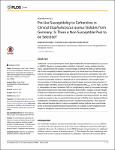Pre-Use Susceptibility to Ceftaroline in Clinical Staphylococcus aureus Isolates from Germany: Is There a Non-Susceptible Pool to be Selected?
Strommenger, Birgit
Layer, Franziska
Klare, Ingo
Werner, Guido
Ceftaroline is a new cephalosporin active against Methicillin-resistant Staphylococcus aureus (MRSA). Based on a representative collection of clinical S. aureus isolates from Germany, supplemented with isolates of clonal lineages ST228 and ST239, we demonstrate the in-vitro susceptibility towards ceftaroline prior to its introduction into clinical use for a total of 219 isolates. Susceptibility testing was performed by broth microdilution, disc diffusion and Etest, respectively. Results were interpreted according to EUCAST guidelines and showed considerable variance in dependence on clonal affiliation of the isolates tested. Among isolates of widespread hospital-associated lineages we found a high proportion of clinical isolates with MICs close to the EUCAST breakpoint (MIC50/90 1.0/1.5 mg/L); currently, interpretation of these “borderline” MICs is complicated by a lack of concordant susceptibility testing methods and reasonable breakpoint determination. Isolates of clonal lineages ST228 and ST239 demonstrated increased MIC50/90 values of 2.5/3.33 mg/L. Sequencing of mecA revealed no association of resistance to a specific mecA polymorphism, but rather reveals two regions in the non-penicillin-binding domain of PbP2a which displayed different combinations of mutations putatively involved in resistance development. This study provides national baseline data to (i) adjust susceptibility testing methods and current breakpoints to clinical and epidemiological requirements, (ii) evaluate current breakpoints with respect to therapeutic outcome and (iii) monitor further resistance evolution.
No license information

